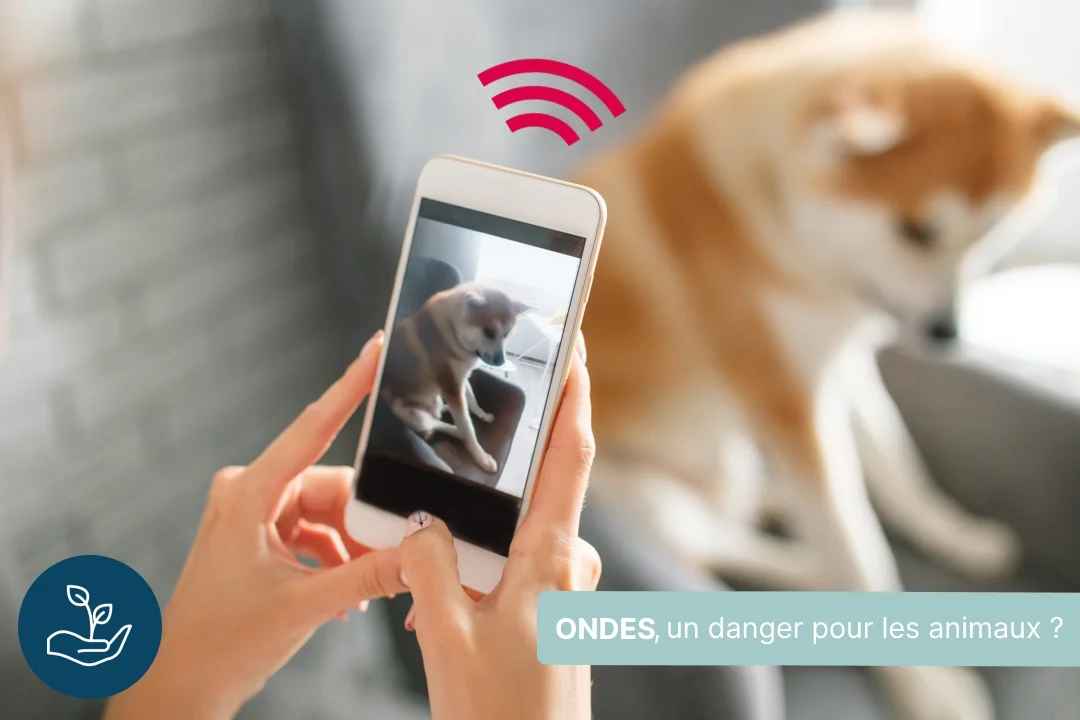Electromagnetic waves are defined as the result of the interaction of a magnetic field and an electric field. In our daily lives, they are emitted by various sources such as cell phones, relay antennas, computers, or even household appliances. There are alsoelectromagnetic fields of natural origin such as the earth's magnetic field or those caused by lightning. Ultraviolet radiation and visible light from the sun also fall into this category. These waves have raised many concerns about their impact on human health, but what about our pets? Are the waves generated by human activity dangerous for their health? In this article, Lore & Science explores this question.
Studies on electromagnetic waves and animal health
According to the conclusions of ANSES, exposure to electromagnetic waves can cause biological effects on humans and animals, including sleep, male fertility in animals, and cognitive performance. However, these effects are considered reversible. They are, for example, temporary changes in the functioning of certain cells or organs, such as those that are constantly observed as part of the normal functioning of the body.
Despite several studies on the impact of electromagnetic waves on the health of animals, especially with laboratory animals, the results remain uncertain. Some of these studies have shown that exposure to high levels of electromagnetic waves can lead to changes in the behavior and physiology of animals, such as increased oxidative stress and changes in heart rate. However, it is important to note that these studies were conducted on animals exposed to abnormally high levels of electromagnetic waves, very different from the daily exposure of our pets.
In addition, studies with pets are still limited and the results are inconclusive. Although the effects of electromagnetic waves on animals are a concern, there is not enough hard evidence to ensure that the waves are harmful to animal or human health. Until further studies are conducted to better understand the effects of waves on animal health, it is best to play it safe to protect our four-legged friends.
The potential dangers of electromagnetic waves
Although scientific data on the effects of electromagnetic waves on pets is still relatively limited, that doesn't stop owners from worrying about potential dangers. Humans have long reported symptoms such as headaches, sleep disturbances, nausea and dizziness from prolonged exposure, raising questions as to whether dogs, cats or even horses may also be similarly affected.
In addition, studies have suggested that the waves may disrupt circadian rhythms (the alternation of day and night), which regulate the physiological functions of many animals in the same way as humans. Pets could be particularly vulnerable to disruptions of these rhythms, as their daily routines are closely tied to those of their owners.
Electromagnetic waves are also suspected of altering the immune system of animals and causing genetic mutations that may increase their risk of developing cancers. While these potential risks are of concern, it is important to note that the scientific evidence in this regard is still limited and more research is needed to determine their magnitude.
Let's keep in mind that electromagnetic waves are omnipresent in our modern environment, and that it is impossible to completely avoid their exposure. However, pet owners can take certain steps to minimize their pets' exposure to electromagnetic sources.
How to protect your pet from electromagnetic waves?
While the effects of electromagnetic waves on animal health are still debatable, there are steps you can take to protect your pet. Pets, such as dogs and cats, can be particularly vulnerable to waves because they spend a lot of time around household electronics, such as televisions, computers and smartphones. In addition, they may also be exposed to waves emitted by cell phone base stations, which are often installed on the roofs of buildings.
There are several ways to protect your pet from electromagnetic waves. The first step is to limit your pet's exposure to wave sources. For example, you can place your pet's basket or litter box away from electronic devices, avoid leaving your pet too close to the television or computer when using them, and move your pet's basket away from the window if there is a cell phone antenna nearby.
In addition, a healthy, balanced diet can help boost your pet's immune system and protect it from the effects of electromagnetic waves. Dietary supplements containing antioxidants, such as vitamin C and selenium, can also help reduce free radical damage and protect cells from the harmful effects of electromagnetic waves.
In sum, although there is no conclusive evidence on the negative impact of electromagnetic waves on the health of animals, it is possible to take measures to minimize their exposure to these waves. To do so, it is recommended to limit the use of electronic devices in their presence, to keep them away from wave sources such as Wi-Fi routers and cell phones, and to avoid leaving them too long near these sources.















8 réactions sur "Waves! Danger to animal health?"
We have an antenna with 4 operators, including 3 in 4 G and 1 in 5 G 280 meters from our home.
Since January 2023, according to the vet, my dog has been having epileptic seizures at the age of 6! Strangely enough, when he's about to have a seizure, he sticks close to the TV antenna sockets or towards the operator's antenna. He's fine when, all of a sudden, he runs off as if he's being remote-controlled or hears something, then within 5 seconds, he collapses as if he's been given an electric shock.
I wonder about the emission field of his microchip coming into contact with electromagnetic fields? What's more, a human hears 20,000 hertz, a dog 40,000, a cat 50,000. With pulsed waves or sounds and his microchip, what's the risk? knowing that puppies have "epileptic seizures" these days!
I hope it's not these kinds of waves that have made my cat ill. It seems he's happy to go outside but doesn't want to come inside anymore.
Hello ,
But how do you make people aware of this problem? I'm electrosensitive, and I've come to hide it. Today, electro-sensitivity is a stigma, and you're seen as a phobic by a considerable number of people, including members of your own family, who accept it with an amused smile ("It's amazing how funny it is, you wouldn't know it! ) Or who accept your handicap outwardly, but shower you copiously with waves and when they discover that you can't sleep in the middle of the night (because of exposure, in my case, that's the main symptom) look sorry, but the next day impose a good deal of extra waves on you, It can't do any harm, since they don't feel anything, and you can't stop everyone else from living, you're a real ayathola, and you've got to adapt, nowadays everything is transmitted via the airwaves, someone very close to me told me over and over again.And then there are your friends, whose houses you go to, whose houses you sleep in, who think you're mentally retarded (or almost), and whom you have to ask tirelessly if it's possible to turn on the switch when they're not using the wifi, and who look scandalized every time: "How come the other mentally ill person hasn't recovered yet, and is still bothering us at home? It's unbearable in the end, he should go and see a shrink once and for all! Well, the end is a little interpreted, but that's pretty much the daily life of an electrosensitive person! And what can we say about the political authorities, who regard us as FRIENDS! The worst thing is that it's all going to get worse, with total indifference and contempt! Thank you very much for reading this.
Gérard Bonnet
My cat died of tongue cancer. I'm wondering about the risk posed by the waves emitted by electronically-identified kibble dispensers?
Hello,
Electro-sensitivity is a proven problem in humans, who have the possibility of expressing themselves (even if they are often only listened to with a distracted ear). However, there are many testimonials from people who attest to the explosion of certain infectious, inflammatory and other diseases when exposed to electronic waves.
For the record, the cells in our bodies have an electrical polarity, precise frequencies, and so it seems obvious that they can be disrupted when external electrical and electronic waves "vibrate" differently.
And to use the right term, we need to talk about electronic pollution, which is significant even if invisible, since we're inundated with transmitting devices and systems of this type.
So if human bodies are "victims" of these disturbances, obviously animals are too.
Sincerely
Hello,
It's certain that the waves from a relay antenna have harmful effects on animals, mine have been victims for many years: a donkey died of a pancreatic tumor; the same goes for 2 of my dogs, a cat with jaw cancer, a dog with epileptic seizures, currently a 4-year-old border collie, liver or pancreas !!!!
the vet advised me to follow up ....
Compré un calefactor de onda larga de luz infrarroja y mi perrita tiembla de miedo y jadea cuando está prendido. Tan fuerte puede ser su efecto?
Si, algunos animales no pueden aguantar algunas ondas